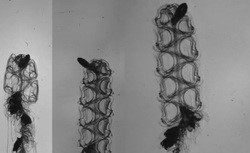September 6, 2015 by Steve Murray
Multi-jet Jellies May Point the Way to Better Underwater Propulsion

N. bijuga nectophore structure
(uoregon.edu)
Squids and octopuses can swim using jet propulsion by forcing water through a mantle. It’s a fast and effective method, and the jet can be steered, but only works in one direction at a time. Engineers, always in search of better undersea vehicle designs, however, are interested in these natural methods of locomotion.
A team of biologists has now found a tiny jellyfish that can maneuver through the water by coordinating multiple jets. The discovery, published in the September 2 issue of Nature Communications, could lead to better, more agile undersea vehicle designs.
Small swimmers
The jellyfish is Nanomia bijuga. Like other jellies, it’s a siphonophore – a “collective” animal composed of many individual organisms. N. bijuga rarely exceeds two inches in length but has tentacles up to a foot long.
The research team collected samples of these jellyfish from floating docks at the University of Washington’s Friday Harbor Laboratories. They collected at night when the jellies were easier to see by shining light into the dark water.
“My first interaction with the animals used in this research was actually swimming with them in their natural environment,” said Kelly Sutherland, a biologist with both the University of Oregon’s Institute of Marine Biology and the Robert D. Clark Honors College on the Eugene campus. “They are vertical migrators, coming to the surface at night and swimming back into the depths during the day. They can swim hundreds of meters each night.”
A single animal, Sutherland said, looks a bit like a bunch of tiny jellyfish strung together. The jellyfish most commonly seen by the public are typically propelled by a single jet. The N. bijuga propulsion system, however, has multiple jets and employs a clever control system to coordinate them.
“The nectophores [swimming bells] of these jellies appear to be fairly simple jet-producing structures,” said John Costello of Providence College in Rhode Island, and lead author of the study.
Motion capture
The researchers placed their jellyfish samples in small tanks and added “tracers” – neutrally-buoyant seeding particles – to the water. The water was then illuminated with a 2-dimensional sheet of laser light, and swimming activity was captured with high-speed (1000 frame-per-second) digital cameras.
The team analyzed their motion data with particle image velocimetry, a technique that tracked the tracer particles in the water and generated measures of fluid flow in the tanks.
They found that N. bijuga maneuvered in the water by coordinating multiple water-shooting jets from the separate – but genetically identical – organisms that make up the animal.
“The younger swimming bells at the tip of the colony are responsible for turning,” said Sutherland. “They generate a lot of torque. The older swimming bells toward the base of the colony are responsible for thrust.”
When swimming forward, the jets produce thrust in a consistent direction. The animal turns by alternating which organisms contract and how strongly they jet. In other words, rather than controlling the physical direction of jets across a collection of organisms, the colony controls which jets operate, and when. The scheme uses a set of simple, uniform components, but a complex control system, to perform rapid and agile movement of the whole animal.
Division of labor
“This is relatively rare in the animal kingdom, said Sutherland. “Most organisms that swim with propulsion do so with a single jet. These siphonophores can turn on a dime, and very rapidly.”
Most animals and human-engineered vehicles rely on jet thrusters that are turned to change directions, a practice that, Sutherland said, is complicated from a design or engineering standpoint.
“These jellies have a slight ability to turn their individual jets, but they don’t need to do it,” she said. “With multiple static jets they can achieve all the maneuverability they need. Designing a system like this would be simple yet elegant. And you have redundancies in the system. If one jet goes out, there would be little loss of propulsion.”
The next step is to understand how animals maximize control of these very basic motion patterns to achieve complex performance. Such understanding should inspire the design of more agile underwater vehicles.
Ultimately, a wide range of engineered marine systems and their users could benefit from the swimming solutions of a unique little jellyfish.
Primary source:
Could tiny jellyfish propulsion drive design of new underwater craft?
